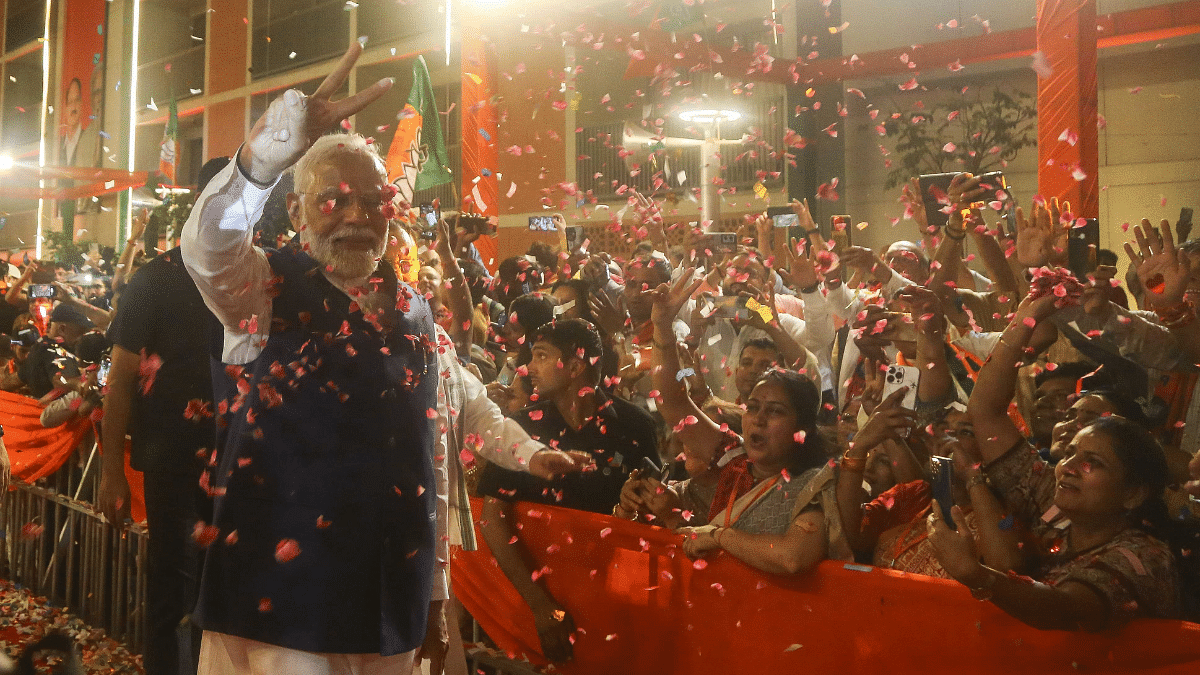New Delhi: Marking a dramatic shift in the country’s politics, the BJP has lost its majority in the Lok Sabha, with the Opposition’s INDIA bloc putting up a formidable show and forcing Narendra Modi to seek the help of coalition partners TDP and JD(U) to secure a third straight term in office.
The people’s mandate dealt a shock to the BJP, which, under Modi’s leadership, had set an ambitious target of winning 400 seats in the 543-member Lok Sabha by repeating its domination of the heartland states, while also expanding footprint in the country’s eastern and southern coast.
But, that was not to be on Tuesday. In a near repeat of 2004, nearly all the exit polls failed to predict the reverses that were headed the BJP’s way, and the surge in the Opposition’s numbers. While final results are awaited in many seats, the Congress is likely to fall one seat shy of the triple digit mark, pulling up its tally from 52 in 2019 to 99 this time.
But it is Telugu Desam Party (TDP) supremo N. Chandrababu Naidu, set to return as the chief minister of Andhra Pradesh, and Bihar Chief Minister Nitish Kumar, the chief of Janata Dal (United), both NDA constituents, who are going to play the role of kingmakers, setting India on course for a coalition government after 2009.
Both in 2014 and 2019 general elections, the BJP had secured absolute majority. The INDIA bloc, formed in Patna last June, is winning over 230 seats, powered by a stunning performance of the Samajwadi Party (SP) in Uttar Pradesh, Trinamool Congress in West Bengal, Dravida Munnetra Kazhagam (DMK) in Tamil Nadu, and Shiv Sena (UBT) and NCP (Sharad Pawar) in Maharashtra.
In fact, among the top five parties by seat count, barring the BJP, the remaining four are INDIA constituents. The BJP received the biggest blow in Uttar Pradesh, where the Samajwadi Party is set to win 37 seats, four more than the BJP, which had bagged 62 seats in 2019, and 71 in 2014.
Worse, the party even lost Faizabad, under which Ayodhya falls, despite it showcasing the construction of the Ram Temple as the fulfilment of a core ideological commitment. The Congress won as many as six seats, including Amethi and Rae Bareli, in the state.
Be that as it may, albeit a diminished force, Modi is set to equal the record of the country’s first Prime Minister Jawaharlal Nehru by getting the opportunity to serve three straight terms.
Nehru, who had steered the Congress to a landslide victory for the third time in 1962, could not complete his last term in office as he passed away in May 1964.
Initially premised on turning India into a developed nation, the BJP’s campaign pitch took a divisive turn after the first phase of polling on 19 April, with the Prime Minister, in speech after speech, raising the spectre of a majority under siege and accusing the Congress of plotting to redistribute the nation’s resources and wealth among Muslims.
He also likened the Congress manifesto to that of the Muslim League. The Congress primarily mounted its campaign on the twin planks of social justice and economic welfare, with Rahul Gandhi promising a socio-economic caste census to address historical injustices and surveys to ascertain the concentration of wealth in India.
In West Bengal, the TMC is on course to win 29 constituencies, seven more than it won last time. The BJP’s tally is down to 12 from 18, instead of doubling as it was expecting and some exit polls also forecast.
In Tamil Nadu, the INDIA bloc had a clean sweep of all 39 seats, led by the DMK’s 22, and the Congress’s nine. It is another state where the BJP had claimed that it was on the rise. The party’s vote share has increased from 3.66 percent to 11.2 percent though.
Even its state chief K. Annamalai, upon whom BJP was banking to shore up its prospects, lost by over 1 lakh votes.
The TMC was not part of the Congress-led UPA I (2004-2009), while the DMK was part of UPA I as well as UPA II (2009-2014). TMC became a part of UPA II, after the Congress increased its tally to 206, but as the coalition tottered with allegations of corruption, DMK exited the bloc.
While the Mamata Banerjee-led party is technically in the INDIA bloc, it did not strike any seat-sharing deal with the Congress and the Left in West Bengal, fielding candidates in the state’s 42 Lok Sabha seats alone. However, Mamata has maintained that she will back the INDIA bloc after the polls.
Maharashtra is another battleground state, where INDIA bloc members Shiv Sena (UBT) and Nationalist Congress Party (Sharad Pawar) have paced ahead of the NDA allies — Shiv Sena (Eknath Shinde) and NCP (Ajit Pawar). While the Shiv Sena and NCP factions contesting under the INDIA bloc’s umbrella won nine and seven seats respectively, the factions allying with the NDA bagged seven and one seat respectively.
(Edited by Tony Rai)
Also Read: ‘Neck-to-neck’ — 2 factions of Shiv Sena emerge as equals in direct contest in 13 seats

